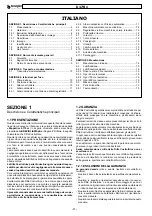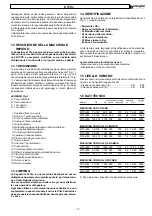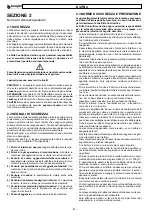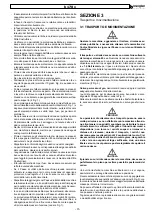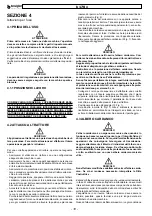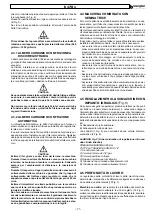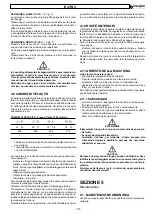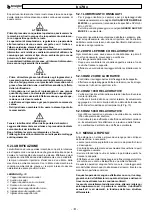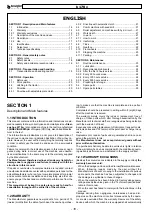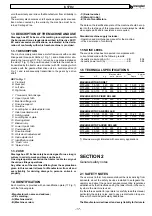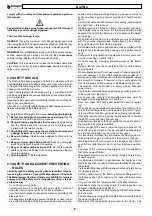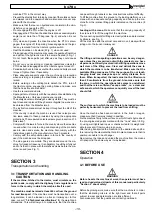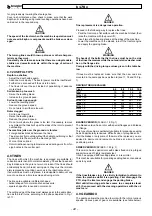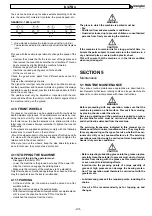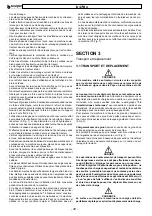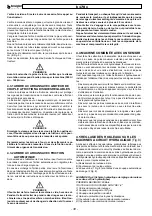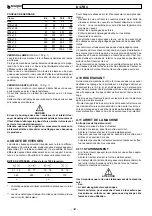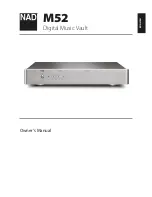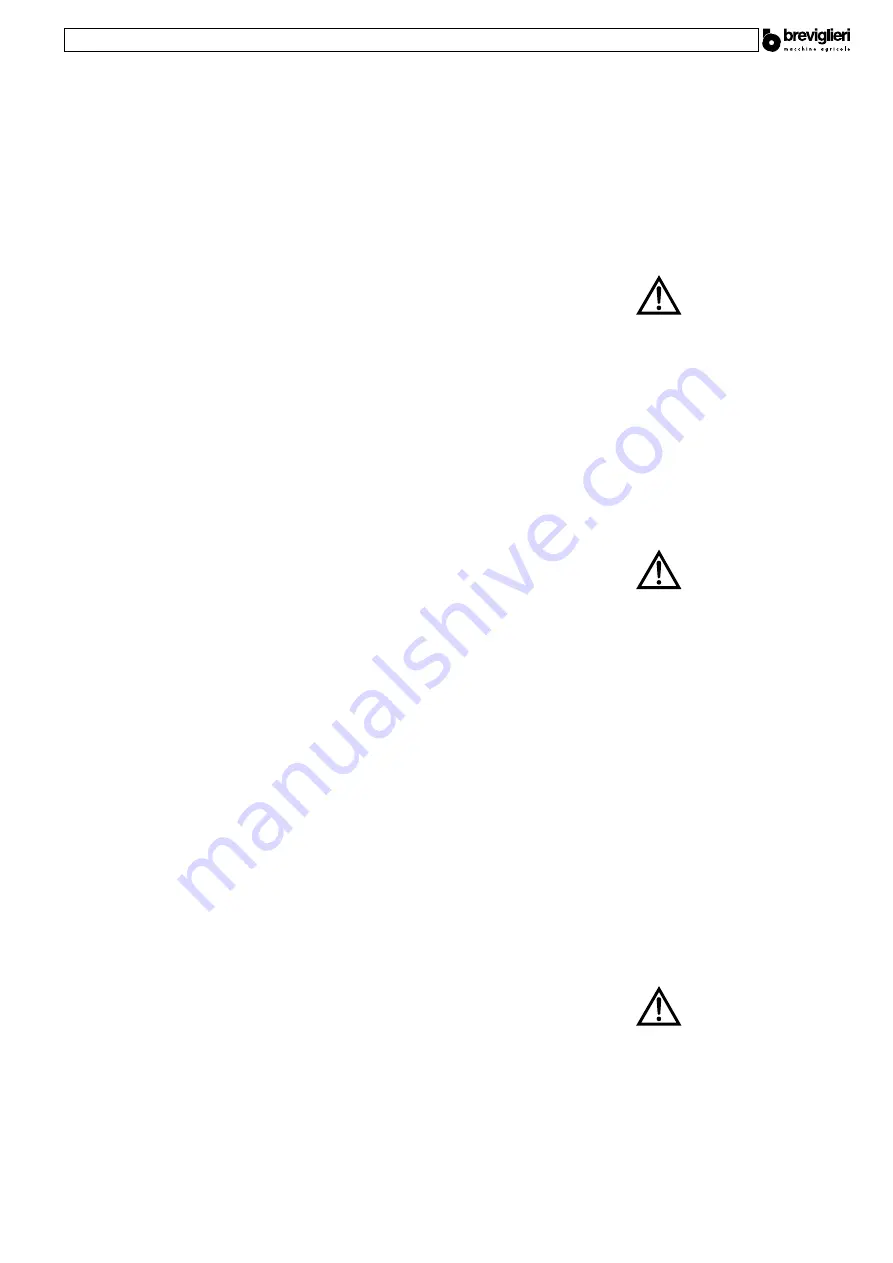
b 170 v
- 19 -
machine PTO in the correct way.
- Prevent the shields from turning by means of the relative chains
and always read the operation and maintenance manual sup-
plied with the driveline.
- Make sure that there are no bystanders or animals in the vicin-
ity before you engage the PTO.
- Do not engage the PTO when the engine is off.
- Disengage the PTO when the driveline is at an excessively wide
angle (never more than 10 degrees, Fig. 4) and when it is not
used.
- Only clean and grease the driveline when the PTO is disen-
gaged, the engine off, the parking brake engaged and the igni-
tion key removed from the tractor’s ignition switch.
- Rest the driveline on its stand (4 Fig. 1) when not used.
- Prolonged use of the machine may cause the gearbox/final drive
and parts of the hydraulic circuit to become heated (5 Fig. 1).
Do not touch these parts just after use as they could cause
burns.
- Do not carry out servicing or cleaning operations unless the
PTO has been disengaged and the tractor engine turned off.
- Periodically check to make sure that the nuts and bolts are well
torqued. Tighten them if necessary.
- Place adequate supports under the machine as a precaution
when servicing or replacing the tines/blades with the machine
raised.
- Before working on the cutting tools, detach the PTO, turn off
the tractor engine, engage the parking brake and make sure
that the tines are at a standstill.
- Use the recommended oils.
- Spare parts must comply with the requirements established by
the Manufacturer. Only use genuine spare parts.
- The safety decals must always be clearly visible. They must be
kept clean and replaced if they become illegible (new ones can
be obtained from the Manufacturer).
- The instruction manual must be kept throughout the life of the
machine.
- If the country in which the machine is used has noise preven-
tion laws, adapt to these provisions by using the appropriate
protections. The measured noise levels are given in section 21.5
Noise level”.
- Comply with the laws in force in the country where the machine
is used when it comes to using and disposing of the products
used to clean and service the machine. Also comply with the
instructions given by the manufacturer of such products.
- Comply with the anti-pollution laws in force in the country of
use if the machine must be scrapped.
- The side guards are mobile. They are closed around the ma-
chine for transport reasons. It is obligatory to pull them fully out
and to fix them in place with the relative screws before the ma-
chine is used (see Fig. 1).
SECTION 3
Transportation and handling
3.1 TRANSPORTATION AND HANDLING
CAUTION
If the machine, hitched to the tractor, must circulate on the
public roads, comply with the Highway Code regulations in
force in the country in which the machine itself is used.
The machine must be raised at least 40 cm from the ground
for road transport. If the machine must be transported over a
long distance, it can be loaded on a truck or railway car. In this
case, consult “1.6 Technical specifications” for the weight and
dimensions. This will allow you to make sure that the machine
can pass through tunnels or low constructions without difficulty.
To lift the machine from the ground to the loading platform, use a
crane with an adequate carrying capacity and hook up the ma-
chine from the relative lifting points indicated on the machine (8
Fig. 3).
Loading with a crane. Make sure that the carrying capacity of
the crane is fit to lift the weight of the machine.
The connecting points for lifting are clearly visible and are marked
by stickers, see Fig. 3.
Lift the machine with the utmost care and move it slowly without
jolting on to the truck or railway car.
DANGER
The lifting and transporting operations can be very danger-
ous unless they are carried out with the greatest care: have
all persons not directly involved in the lifting operations move
well clear of the lifting area. Clear and delimit the zone to
which the machine is to be transferred. Make sure that the
available lifting means are fit for the purpose. Do not touch
hanging loads and always keep at a safety distance from
them. When transported, the loads must not be lifted more
than 20 centimeters from the ground. Also make sure that
the zone in which the operations take place is uncluttered
and that there is a sufficient “escape route”, i.e. a clear and
safe zone to which the operators can quickly move if the load
should fall.
CAUTION
The surface on to which the machine is to be loaded must be
perfectly horizontal, to prevent the load from shifting.
Once the machine has been moved on to the truck or wagon,
make sure that it remains locked in position.
Fix the machine firmly to the surface on which it rests by means of
the pre-engineered points marked with the “hook” decal (8 Fig.
3), using well tightened ropes or chains suited to its weight and
able to prevent it from moving in any way.
After having transported the machine to the desired site and be-
fore removing the elements that hold it in place, make sure that its
position is unable to be of danger.
Now remove the ropes and unload the machine from the means
of transport in the same way as it was loaded.
SECTION 4
Operation
4.1 BEFORE USE
WARNING
Before he sets the machine at work, the operator must have
read and understood all parts of this manual and particularly
“Section 2” about safety.
Before beginning work, make sure that the machine is in order,
that the lubricating oils are at the right level and that all parts
subject to wear and deterioration are fully efficient.
Also make sure that the guards are correctly positioned.
Summary of Contents for b170v-250
Page 4: ... 4 b 170 v Fig 4 Fig 3 Fig 5 A B 1 3 MAX MIN 4 cm Fig 6 Fig 7 A 1 2 3 4 5 6 7 8 ...
Page 5: ...b 170 v 5 Fig 9 Fig 8 1 2 3 4 A B 1 2 3 4 5 Fig 10 A 6 7 ...
Page 67: ...b 170 v 67 Tav 12 ...
Page 68: ... 68 b 170 v Tav 13 ...
Page 69: ...b 170 v 69 Tav 14 Cod 8065847 ...
Page 70: ... 70 b 170 v Tav 15 Cod 8065842 ...
Page 71: ...b 170 v Note ...


